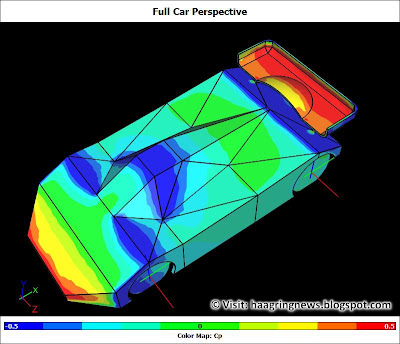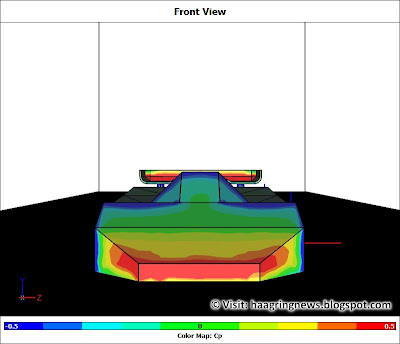Saturday, June 4, 2011
Thursday, June 2, 2011
Virtual Wind Tunnel: June 02, 2011 Update
This is a general update on all the recent CFD "virtual wind tunnel" simulations of a Kyosho Mini-Z MR03 Mazda 787b 3D model.
In addition to the configurations tested previously (no wing, flat rear wing, 15, 30, 45 and 60 degree rear wing) three additional ones were considered: broken wing, gurney flap, and scoop wing.
The table below shows drag and down forces for all the different rear wing configurations tested:
Drag (gf)
|
Down Force (gf)
| |
No Rear Wing
|
6.2
|
- 7.8 (lift)
|
Broken Wing
|
6.4
|
- 3.8 (lift)
|
0o Rear Wing
|
6.6
|
- 0.5 (lift)
|
15o Rear Wing
|
7.7
|
4.6
|
Gurney Flap
|
7.2
|
5.7
|
30o Rear Wing
|
8.9
|
8.0
|
45o Rear Wing
|
10.1
|
8.5
|
60o Rear Wing
|
10.6
|
9.3
|
Scoop Wing
|
11.7
|
13.5
|
A chart showing these results, and the trade off between drag and down forces, is available here.
All values above consider the car "racing" at 10 m/s (36 km/h). Charts showing the results for other speeds (2.5, 5.0, 7.5 in addition to 10 m/s) are available here.
Detailed results and pictures for each of the simulations are posted in the following links:
Virtual Wind Tunnel: No Rear Wing
Virtual Wind Tunnel: Broken Rear Wing
Virtual Wind Tunnel: Flat Rear Wing
Virtual Wind Tunnel: 15 Degree Rear Wing
Virtual Wind Tunnel: Broken Rear Wing
Virtual Wind Tunnel: Flat Rear Wing
Virtual Wind Tunnel: 15 Degree Rear Wing
Virtual Wind Tunnel: 60 Degree Rear Wing
Virtual Wind Tunnel: Scoop Wing
Virtual Wind Tunnel: Scoop Wing
Streamlines, pictures showing the theoretical trajectory of particles flowing around the car are posted here (colored according to pressure coefficient - Cp) and here (colored by air speed).
Videos of vertical plane streamlines, "3D" streamlines and particle tracks are also available.
Once again, all results come from a computer simulation of a Kyosho Mini-Z MR03 3D model, resembling a Mazda 787b car body. None of the results have been validated empirically at a real wind tunnel, so all the typical CFD caveats apply.
Once again, all results come from a computer simulation of a Kyosho Mini-Z MR03 3D model, resembling a Mazda 787b car body. None of the results have been validated empirically at a real wind tunnel, so all the typical CFD caveats apply.
Wednesday, June 1, 2011
Virtual Wind Tunnel: Scoop Wing
These are the results of a CFD "virtual wind tunnel" simulation of a Kyosho Mini-Z MR03 Mazda 787b 3D model with a scoop wing.
The drag force recorded by the simulation while the car was "racing" at 10 m/s (36 km/h) was 11.7 gf. The down force recorded by the simulation at this speed was 13.5 gf.
The pictures below show the pressure coefficient (Cp) indicating high (red) and low (blue) pressure areas.
For complete results of the Mini-Z MR-03 CFD "virtual wind tunnel" simulation click here.
The drag force recorded by the simulation while the car was "racing" at 10 m/s (36 km/h) was 11.7 gf. The down force recorded by the simulation at this speed was 13.5 gf.
The pictures below show the pressure coefficient (Cp) indicating high (red) and low (blue) pressure areas.
Virtual Wind Tunnel: Gurney Flap
These are the results of a CFD "virtual wind tunnel" simulation of a Kyosho Mini-Z MR03 Mazda 787b 3D model with a 4 mm gurney flap.
The drag force recorded by the simulation while the car was "racing" at 10 m/s (36 km/h) was 7.2 gf. The down force recorded by the simulation at this speed was 5.7 gf.
The pictures below show the pressure coefficient (Cp) indicating high (red) and low (blue) pressure areas.
For complete results of the Mini-Z MR-03 CFD "virtual wind tunnel" simulation click here.
The drag force recorded by the simulation while the car was "racing" at 10 m/s (36 km/h) was 7.2 gf. The down force recorded by the simulation at this speed was 5.7 gf.
The pictures below show the pressure coefficient (Cp) indicating high (red) and low (blue) pressure areas.
Virtual Wind Tunnel: Broken Wing
I broke the rear wing of my real Kyosho Mini-Z MR03 Mazda 787b last night while racing at Haagring. So I decided, just for fun, to run a CFD "virtual wind tunnel" simulation of a broken rear wing.
The results were the following: the drag force recorded by the simulation while the car was "racing" at 10 m/s (36 km/h) was 6.4 gf. The down force recorded by the simulation at this speed was - 3.8 gf, that is, 3.8 gf of lift. No significant lateral forces were measured, in spite of the asymmetric wing configuration.
The pictures below show the pressure coefficient (Cp) indicating high (red) and low (blue) pressure areas.
For complete results of the Mini-Z MR-03 CFD "virtual wind tunnel" simulation click here.
The results were the following: the drag force recorded by the simulation while the car was "racing" at 10 m/s (36 km/h) was 6.4 gf. The down force recorded by the simulation at this speed was - 3.8 gf, that is, 3.8 gf of lift. No significant lateral forces were measured, in spite of the asymmetric wing configuration.
The pictures below show the pressure coefficient (Cp) indicating high (red) and low (blue) pressure areas.
Subscribe to:
Posts (Atom)



























